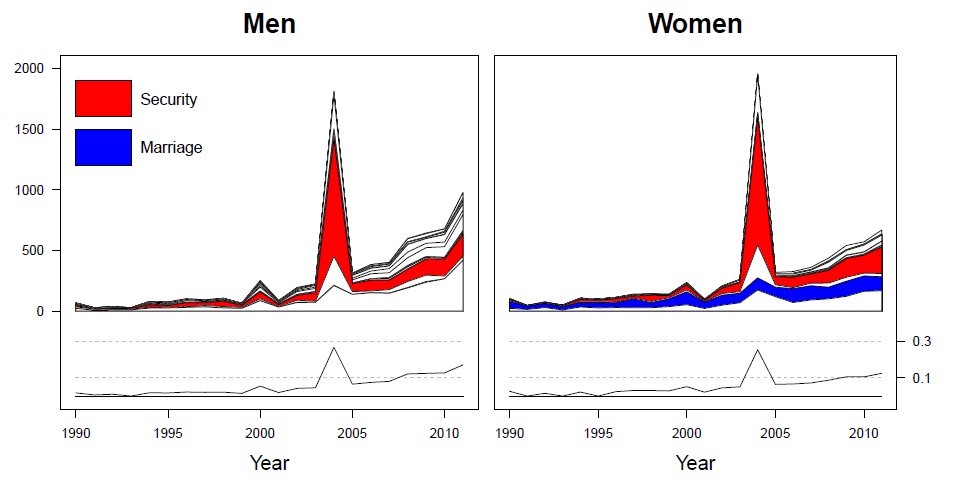To obtain a deep understanding of migration patterns in the DRC I conducted a survey in 24 randomly selected villages of the Buhavu Chiefdom in Congo's South Kivu province -- an area known for its large migrant populations in part due to conflict.
[1] The research villages are located close to Lake Kivu and have in recent years been a safe haven for people (mainly Tembo and Rwandan (Hutu and Tutsi)) fleeing attacks by a.o. the FDLR in the mountains more to the west. This is also the area where spent most of the 18 months that I've been in the Congo, including three months living inside these villages to conduct ethnographic research on native-migrant interactions.
For the heads of a total of 4,015 households -- and their spouse(s) -- I collected information about all villages the individuals have lived in during their life (for at least a month), the year for all migrations between these villages and the reason for these movements, including return migrations. The data is rich and includes information for 8,199 adults and a combined total of 18,282 movements.
Migration features prominently in the Buhavu chiefdom. Of the individuals in our sample 85% have moved at least once in their life, and more than two-thirds currently live outside of their village of birth.
[2] Migration patterns in the Buhavu chiefdom are best characterized by rural-rural migration. There are two major cities located near the Buhavu chiefdom: Bukavu and Goma, respectively the capitals of the South Kivu and North Kivu provinces. Of the 18,282 movement destinations mentioned, Bukavu and Goma were mentioned only 511 (3%) and 775 (4%) times. The main reason to visit these cities was for work or family, and these visits were often brief -- the majority moved back to the rural area that same year, and almost 90% moved back within two years.
[3]
Fig 1: Migration in Congo's South Kivu province
Click to enlarge!
The survey also collected detailed information about the reasons for migration asking for each of the 18,282 movements why the movement took place. We find that while people migrate for a diverse set of reasons, two stand out: marriage and security. The figure above plots the number of movements by reason for migration per year, divided by gender. Among the ethnic groups in this area of the Democratic Republic of Congo men marry women from outside their village. The women then moves to the village of her husband. This dynamic is well illustrated in the figure by the absence and importance of marriage as a reason for migration for women and men, respectively.
Unsurprisingly, migration due to insecurity -- indicated in red -- is an important driver for migration in this region. In 2004 in particular we see a large spike in insecurity-induced migration. The reason for this spike was a rebellion by the rebel general Laurent Nkunda who moved in 2004 from Goma to Bukavu right through the Buhavu Chiefdom, which culminated with the struggle for control of Bukavu.
The lower panels in the figure plot the share of individuals that moved per year. We find that almost 30% of the population moved in 2004. While migration levels are no longer at its 2004 level, around 10% still moves every year.
Disclaimer:
This is the first set of result from work in progress. Given the rich data more will be done with it.
Footnotes:
[1] The dataframe used was a dataset created together with the International Rescue Committee and CARE International in 2010 that includes all villages in the Buhavu Chiefdom. The selection of the villages was conditioned on the presence of migrants (more than 25 migrant households) and basic safety conditions for the surveyors.
[2] A large survey conducted in 2007 in over 600 randomly-selected villages throughout Eastern Congo confirms these numbers and finds that a full 71% of individuals in the South Kivu sample were reported as having fled at least once at some point during the period from 1996 to 2007 due to armed activities by organized armed groups or militias. See:
here.
[3] To be confident that this result is not driven by individuals that did not return to our survey villages I compared per village the household list created from the census in 2012, with household lists that was created in 2010 for another project. The presence of a household on the latter but not on the first would evidence for death or outmigration. For those households that migrated out of the village I obtained their ethnic membership, the reason for outmigration and their destination. Few moved to Bukavu or Goma.
